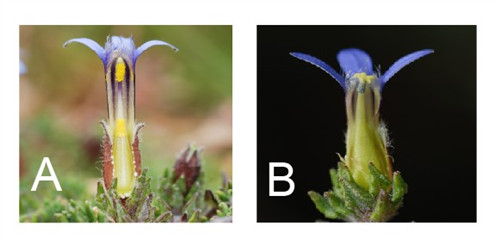Cyananthus (Campanulaceae) is a small genus consistingof ca. 20 species endemic to the Sino-Himalayan region, and it was proposed as one of the most primitive genera of Campanulaceae. Three sections within Cyananthus based on habit, corolla lobes, and types of trichomes on the calyx are recognized: sect. Cyananthus, sect. Stenolobi Franch. and sect. Annui (Lian) Hong et Ma. SUN Hang’s group, from Kunming Institute of Botany, based on phylogenetic analysis using nuclear ribosomal ITS and four plastid markers (matK, rbcL, psbA-trnH and trnG-S), the results strongly support the monophyly of Cyananthus and its close relationship with the Codonopsis clade of the platycodonoids. Three major clades are supported, corresponding to the three sections of the genus, with sect. Cyananthus, which mainlyoccurs in the Himalayas, being a sister to the clade comprising the other twosections (sect. Stenolobi and sect. Annui) distributed primarily in the Hengduan Mountain region. Molecular dating and biogeographic analysis with LAGRANGE support dispersal from the Himalayas to the Hengduan Mountains during the early evolution of Cyananthus. The lineage diversified in the Hengduan Mountain region to formsect. Stenolobi and sect. Annui, and the lineage remaining in the Himalayas evolved to become the current sect. Cyananthus. Vicariance mechnism resulting from the extensive uplift of theQinghai-Tibetan Plateau and the Hengduan Mountains played an important role in the subsequent diversification of the genus. The results also observed that Cyananthus exhibits variation in itssexual system, possessing both hermaphroditic and gynodioecious species. Character evolution analyses using Mesquite suggest that gynodioecy evolved from hermaphroditism only once in sect. Stenolobi, but thatthere is a reversal in C. formosus.
This study is published in Molecular Phylogenetics and Evolution ( 2013.68: 482-497), and was supported by grants-in-aid from the National Natural Science Foundation of China (NSFC, 40930209, 31200183, U 1136601), Strategic Priority Research Program (B) of the Chinese Academy of Sciences (XDB03030112), Hundred Talents Program of the Chinese Academy of Sciences (2011312D11022 ).

Selected species from three sections of Cyananthus, the distributional map and strict consensus tree derived from maximum parismony analysis

Hermaphroditic flower (A) and female flower (B) of Cyananthus delavayi.




